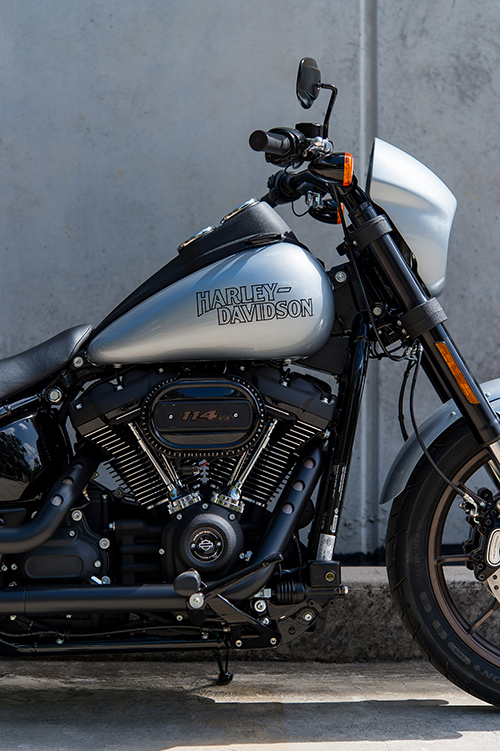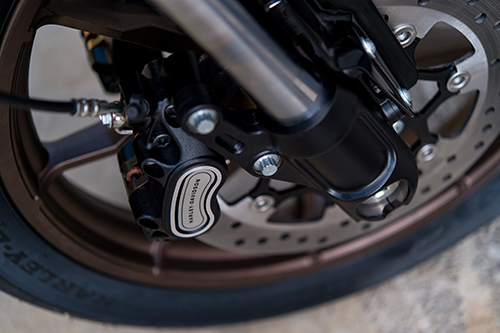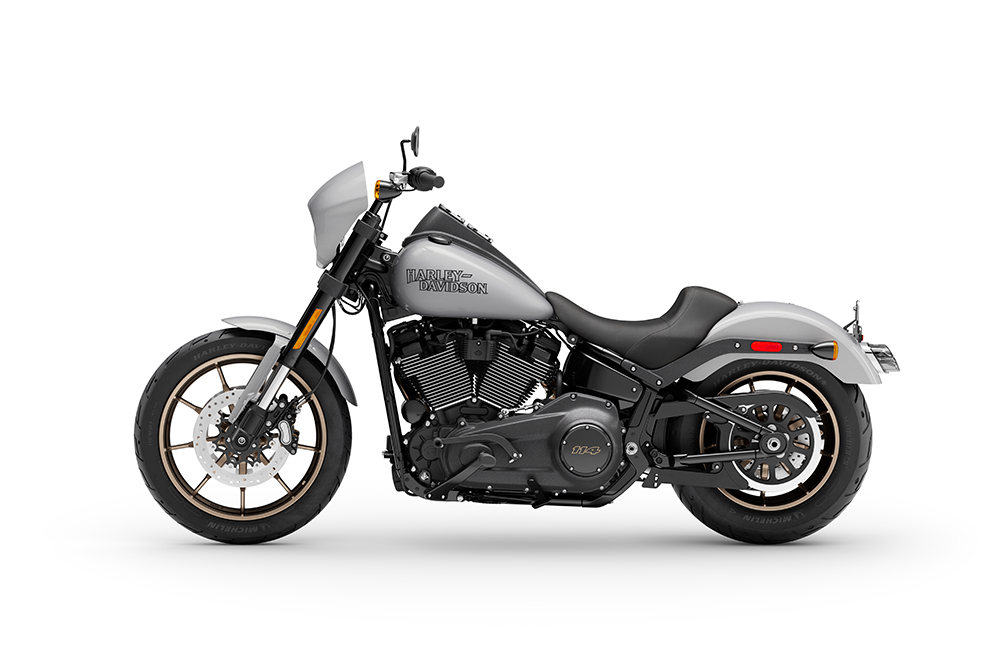Classic looks, modern power, sharper handling – could the new Softail Lowrider S be the Harley-Davidson you’ve been waiting for?
There’s a tune running round my head and I can’t shift it: Low. Ri. Der. Ride a little higher… But I’ll just have to hum it as the new Harley-Davidson Lowrider S is part of the Softail family and, unlike the touring models, doesn’t come with a stereo. It’s an appropriate soundtrack for this bike in every way; a sun-soaked 1970s classic everyone can recognise. Plus, taken literally, the new-for-2020 model has a 5mm higher seat than the Dyna Lowrider S that ran until 2017.
When Harley stopped producing the Dyna line at the end of 2017, it meant popular models like the Lowriders had to be reimagined around the Softail range, using the freshly unveiled (and more powerful) Milwaukee Eight motor. Where the Softail Lowrider introduced in 2018 uses the 1746cc (107 cubic-inch) version of the motor, this new Lowrider S gets the more muscular 1868cc (114 cu-in), but there’s a lot more to the S model than just a bigger motor.
As with all Harleys, the styling is critical. To the uninitiated, one cruiser may look like another but the differences, though subtle, are significant. The design is a statement, telling other Harley owners what kind of rider you are, and the look of the Lowrider S tells those in the know that this is a performance machine. The compact fairing around the circular LED headlight; upside-down fork; mid-position footpegs; bronze-finish wheels; and, most important of all, its all-black bits – the frame, exhausts and engine (apart from the chrome pushrod covers) are black. There’s even a smoked cover on the LED tail light. It all says that owning this bike is more about riding than polishing chrome.

The overall look of the Lowrider S nods to the style of the West-Coast custom scene of the 1970s, right down to the subtle outline font used for the Harley-Davidson name on the tank. The sharp look of those earlier choppers is echoed in the way the ramp of the tank-mounted instruments exaggerates the line from the handlebars to single seat. The bars are high, a single-piece bar raised on 100mm risers. The aggressive look is helped by the way the upside-down fork is raked out less than the right-way-up ones of the Lowrider (28° rather than the 30° of the base machine). These differences should set this S model apart from the Lowrider.
I’ve had plenty of time to walk around the bike, thinking about the looks, as torrential rain has delayed the start of our test ride. But now the clouds have finally packed it in, it’s time for me to see if there’s enough go to back up all the show.
You can probably tell from the pictures: I’m a big bloke, 195cm tall. Settling into the 690mm seat for the first time feels like lowering myself onto a bar stool that’s just a bit lower than I expected. The mid-position footpegs are wide and just where I want to put my feet… when they’re on the floor. So I find my feet splayed further apart than feels natural. That flat bar on the risers sits at the perfect height for me and when I pull away and get my feet on the pegs for the first time, the riding position feels really natural for someone more used to roadbikes than cruisers.
There are three versions of Harley-Davidson’s Miluwaukee Eight engine, each named after its capacity in cubic inches. The 107 is the most commonly used – the base-level engine, if you like. There’s a 117 (1923cc) fitted in the limited-run Custom Vehicle Operation (CVO) machines. The 114 version is used in the special models and those with a bit more performance. It’s definitely my favourite of the three motors: as precise and biddable at low revs as the 107, for excellent low-speed manners, but as I pull onto the road and crack the throttle for the first time it delivers fearsome drive – but without the extra aggression of the more powerful 117 unit.

Frankly, that’s a good thing on the still-damp roads of the Ku-ring-gai Chase National Park, as there’s no traction control. As well as splashes of standing water, the first stretch of road has some serious bumps – most of which are transmitted directly to my spine. The Lowrider S has a preload adjuster for the rear shock beneath the seat and, to be fair to the bike, perhaps the ride would be smoother if I’d cranked it up a bit – though experience of previous models suggests it wouldn’t make that much difference…
Anyway, the forks are totally non-adjustable so the set-up can’t be fully tailored to suit the rider, as on a sportsbike. It’s better just to get on with riding it.
And the Lowrider S does ride well, especially turning onto a smoother section of road where I can really work the throttle. This motor drives beautifully out of corners – it’s smooth, the fuelling is precise and boy, does it have some grunt. Peak torque is a whopping 161Nm at 3000rpm, but there’s a real sense of urgency to the acceleration when the tacho hits two grand. The redline is at 6000rpm but there’s not a great deal of extra acceleration in the final 1500rpm, so I find it better to swap cogs between 4000-4500rpm.
The clutch action is smooth and fairly light, the gearbox slick. Speed rises as the engine takes on a throaty note, speed building rapidly – it’ll happily carry the speed limit in third gear, though it’s more relaxed in fourth. At that point, the accurate throttle rolls speed on and off pretty effortlessly, as there’s enough engine-braking to keep it flowing smoothly through the open corners.

Of course, it can go plenty quicker than the limit. Get a big enough straight to hold on to sixth gear and you’re likely to nudge the needle up to the 160km/h mark on the analogue speedo. That doesn’t feel natural, though. The compact bikini fairing doesn’t offer a great deal of protection from the windblast and the gentle oscillation of that 19-inch front, wagging the bars gently, encourages me to have a quiet word with myself. Chasing top speed on a Lowrider S is like eating your food off a shovel… it is possible, but there are better tools for that job.
Anyway, this one’s better suited to a different task – rolling through sweeping turns and carrying a surprising amount of corner speed. The mid-set footpegs are in no rush to touch down (even though, on paper, the S has 10mm less ground clearance than the base Lowrider). When they do touch, they’re gently hinged and the bike isn’t unsettled at all. It holds its line fairly accurately but is generally happy to adjust it. Tighter turns do need more input from the rider to get the bike turning quickly.
Sharp corners also mean a bit of braking: the engine braking might be enough to adjust speed for sweepers, but losing a good chunk of velocity calls for a firm squeeze of the brake lever (unlike some other Harleys I’ve ridden, the front is definitely more powerful than the back). It’s best to get the braking done in a straight line, as the Brembo ABS system isn’t a cornering-ABS set-up. It’s a good one, though – it comes on only when I deliberately try to set it off on a wet surface, then backs off quickly.
I spend an hour or two on the twisty national park roads and the Lowrider S really delivers the goods: a quick, involving, fun ride. It really suits this kind of riding and could surprise anyone who thinks cruisers are slow and don’t go around corners. Don’t get me wrong: at the end of the day, a Street Triple or Fireblade would still eat it alive… but only if the rider was trying. For the most part, this is a cruiser that can hold its own on a great biking road.

Leaving Ku-ring-gai Chase and heading back towards Sydney’s Northern Beaches, the Lowrider S really comes into its own. All that easy torque between 2000-4000rpm makes light work of traffic – it’s a winner at the traffic-light GP, leaving cars and cyclists spinning in its wake. At 50km/h it purrs along in third gear or snarls a bit in second, with instant roll-on power just a twitch of the throttle away. Better still, it looks the business and cruises past the cafes with enough of a rumble to turn a few heads without being noisy enough to offend anyone.
Now I’m negotiating junctions, I’m also having to remember how Harley’s self-cancelling indicators work: one button on each bar; press to start indicating left or right as required. It takes me a while to get used to not pressing to cancel… I keep setting them off again after I’ve gone round a corner. It’s a minor niggle and I know that, when you’re on the bike for a period of days (or when it’s your bike) you do get used to it.
I’m not sure I’ll ever get used to the tank-mounted instruments, though. It takes more than a glance to read them and I don’t like looking away from the road so completely. Perhaps that’s exaggerated because I’m so tall. Certainly, as the ride goes on my height poses other challenges for the Lowrider. While I found the riding position surprisingly natural and comfortable on the twisties, head low over the bars while chasing apexes (they all got away), I find the more upright, more relaxed city riding puts a little strain on my lower back – but the less lanky riders on the test don’t seem to have any issues.

So is the Lowrider S for you? Okay, perhaps not if you’re a second-row forward, but if you’re under six-foot-two, you’ll be fine. It has a lot to recommend it: great looks, good low-speed manners, a thumping turn of acceleration and decent handling. Set against it, the suspension is basic, there’s no traction control, no pillion seat and it’s sporty only in cruiser terms, rather than being a genuinely sporty bike.
If you’re already a Harley owner, the styling probably suggested a lot of that – so the short verdict is that its performance is as good as it looks. It could be a logical next bike for someone riding a sportster or an older Dyna or Softail model. The real question is, could this be the bike to win you over if you’re not already a Harley owner? Plenty of people are coming to the brand – H-D sales have been strong in Australia recently, growing by 20 percent, and Harley CEO Matt Levatich boasted at the briefing before our test ride that the company has “never made better motorcycles”.
The Lowrider S could easily win more converts, as delivers classic Harley-Davidson style and comes with an easy and familiar riding position, good handling, that glorious motor… and with its own soundtrack, too…

MY20 FXLRS. Low Rider S. Softail.